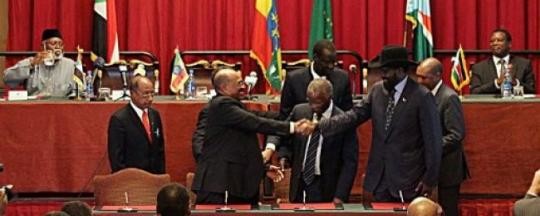Explaining the Addis Agreements: Debt

Sudan and South Sudan agreed last September on several provisions designed to help offset the impact of Khartoum’s loss of southern oil revenues by relieving its external debt burden. After significant delays, these provisions have effectively been restored by the new implementation timetable that emerged out of recent breakthrough talks.
Last year on 27 September at a presidential summit in the Ethiopian capital the two countries committed to a package of deals including an ‘Agreement on Certain Economic Matters.’ This deal committed the two countries to a ‘zero-option approach,’ by which Sudan agreed to retain the entire debt burden, provided that South Sudan help it diplomatically to campaign for debt relief.
The agreement stated that if efforts to secure debt relief later failed, the two countries would enter into new negotiations to share the liability. Potentially, therefore, a share of the external debts could be apportioned to South Sudan. But the agreement added that debt relief efforts would only be deemed to have failed if after two years Sudan is still blocked from the initiative of the World Bank and International Monetary Fund for Heavily Indebted Poor Countries (HIPC).
As suggested by remarks of the finance undersecretary in Khartoum earlier this month, the Sudanese government strongly desires to participate in this initiative. But the country remains blocked from the HIPC initiative, along with Eritrea and Somalia, because it has yet to reach the ‘decision point’ set by the IMF directors as the standard of eligibility.
Excerpt: “Agreed Zero-Option Approach: The two States hereby agree that the RoS, as the continuing state, shall retain all external debt liabilities and external assets of the RoS. The two States shall take all necessary steps, including through a joint creditor outreach strategy to secure from international creditors a firm commitment to provide comprehensive relief of the external debt of the RoS (3.1.1.-3.1.2).”
“Trigger for Potential Apportionment of External Debts and Assets: If the firm commitment from international creditors regarding the relief for the external debt of the RoS is not secured, the Agreed Zero Option shall cease to apply. Upon the Agreed Zero Option ceasing to apply, the two States shall enter into good faith negotiations to conclude apportionment of the external debt of the RoS and its external assets (3.2.1-3.2.2).”
Background: Sudan’s external debt hit $41.4 billion in 2011, according to recent IMF figures. The government a year ago planned to rally international support for debt relief at a conference in Istanbul supported by Norway and Turkey, but the event was called off after the United States declined to attend and quietly lobbied for postponement.
Subsequently, talks on debt became a major part of the diplomacy in the run-up to the Addis Ababa agreement, involving negotiations among Sudan, the U.S., Qatar, and other major creditor nations. When the agreement came, the debt question was broadly settled, but the technical stipulations were few or none, suggesting that the inclusion of terms on debt were less a matter of settling the apportionment question per se and more a means by which the African mediation signaled to Khartoum that the peace deal overall would eventually pay off.
Within weeks of signing, the pay-off seemed already near when Sudan’s finance minister announced upon return from the annual meeting of the IMF and World Bank in Tokyo that "a great degree of international acceptance" toward debt cancellation had emerged.
Much of that ‘acceptance’ then disappeared during the political and diplomatic crises of November. The debt issue re-gained some momentum during the round of talks from 13 to 18 January by the lead negotiating panel, which resolved again to look jointly for ways to seek economic relief.
Implications: The preservation of the Addis Ababa deals depend, of course, on the survival of the Sudanese state, which in turn depends in no small measure on the fiscal and monetary stability of the struggling Sudanese economy. External debt is only a part of that equation, especially since the country continues to attract foreign investment, but nonetheless a critical part.
IMF and World Bank economists in Khartoum will have a role in determining Sudan’s eligibility for the HIPC Initiative. But part of that determination will also be political, because one of the conditions for participation in the relief initiative is ‘a track record of reform.’
Ultimately, the decision will be subject to approval by the IMF’s Executive Board, whose largest voting bloc is controlled by the United States. In former years this country has threatened to use its directorship at the Fund to exercise a de facto veto power on debt relief for Sudan.
African Union mediators, however, have pledged to plan a diplomatic push for debt relief. In their revised timetable for the Cooperation Agreement signed by the countries’ lead negotiators 12 March, the mediators set a goal of 17 March for establishing a tripartite committee comprised of two representatives each of Sudan, South Sudan and the African Union mediation to discuss how to jointly approach creditor nations to request debt relief.
Not to be confused…: Though the South Sudanese government has assented to lobby jointly for debt relief for their neighbor to the north, this commitment is largely nominal. A culture of mistrust and rivalry still prevails, preventing genuine diplomatic coordination on economic policy. Until now, Sudan’s ongoing consultations with the World Bank, International Monetary Fund and African Development Bank have been strictly bilateral, and are likely to remain so.
See also:
Explaining the Addis Agreements: Pensions
Explaining the Addis Agreements: Oil Fees
Explaining the Addis Agreements: Border Demarcation
Explaining the Addis Agreements: Border Monitoring